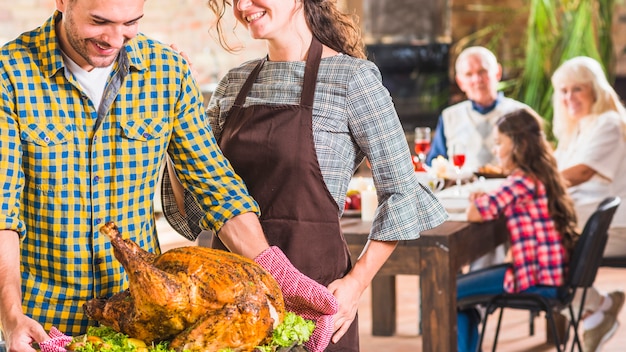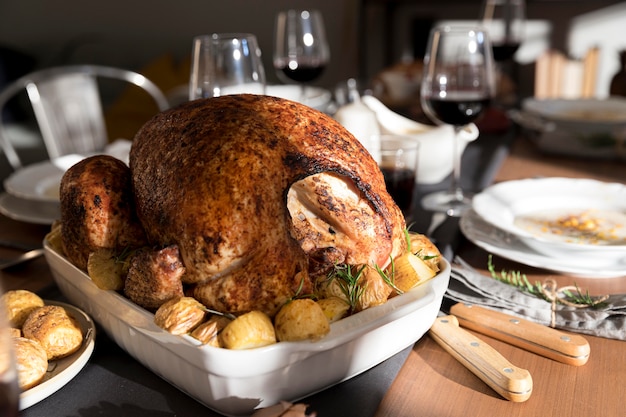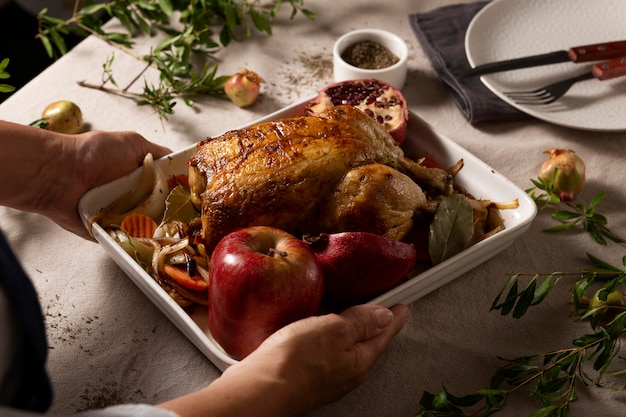(Part 1) The perfect turkey: Choosing Your Bird

Size Matters:
First things first, you need to choose the right size turkey for your gathering. You don't want to end up with a tiny bird that's devoured in a flash, or a massive one that takes up half the table and requires a team of hungry guests to tackle. As a general rule of thumb, allow about 1 lb (0.5 kg) per person. So, for a family of six, you'd need a 6-7 lb (2.7-3.2 kg) turkey.
However, this is just a starting point. If you're expecting a group with big appetites, or if you plan on having lots of leftover turkey for sandwiches and other dishes, you might want to go for a larger bird. Don't be afraid to err on the side of caution. A slightly larger turkey is better than a smaller one that leaves your guests wanting more.
Fresh or Frozen?
This is a question that often divides turkey enthusiasts. I'm a big fan of fresh turkeys, as I find they tend to have a more delicate flavour and a slightly juicier texture. However, frozen turkeys are perfectly fine too, and can be a lifesaver if you’re short on time. They're usually available at a lower cost than fresh turkeys too, which is a bonus.
If you're using a frozen turkey, make sure you give it ample time to defrost in the fridge. I'm talking at least 24 hours for every 5 lb (2.3 kg) of turkey. Don't even think about defrosting a turkey at room temperature, as this can encourage the growth of harmful bacteria.
Free-Range or Conventional?
If you're feeling a bit fancy, opt for a free-range turkey. You'll often find they have a more pronounced flavour, a richer colour, and a lovely golden skin. Free-range turkeys have access to outdoor space and are typically fed a more natural diet, which can contribute to their superior flavour. However, conventional turkeys are perfectly acceptable and won't break the bank. They're readily available and often come in a wider range of sizes, so they're a good option if you're looking for a more budget-friendly choice.
(Part 2) The Prep Work: Getting Your Bird Ready to Roast

Thaw and Dry:
If you're using a frozen turkey, make sure it’s completely thawed before you start the prep. This can take several days, so plan ahead. Once thawed, pat the turkey dry with kitchen paper. This will help the skin crisp up beautifully in the oven. A dry skin is crucial for achieving that lovely golden-brown colour we all crave.
Butter or Oil:
Slather the turkey with butter or oil. This will add flavour and help the skin to become gloriously golden brown. I prefer to use a combination of butter and oil, as the butter adds a richer flavour, while the oil helps to prevent the skin from sticking to the roasting pan. You can also add some herbs to the butter mixture, such as rosemary, thyme, or sage, for an extra burst of flavour.
Seasoning:
Now for the fun part – seasoning! You can stick to the classic salt and pepper combo, or get creative with your favourite herbs and spices. I like to add a generous pinch of rosemary, thyme, and a touch of garlic powder. Don’t be afraid to experiment and find your own signature blend. A good seasoning will enhance the natural flavour of the turkey and add a delicious aroma to your kitchen.
If you're feeling adventurous, you could try a citrus-based rub, a spice blend inspired by your favourite cuisine, or even a simple combination of fresh herbs from your garden. The possibilities are endless! Just remember to season generously, as the flavour will intensify as the turkey cooks.
Stuffing:
This is a matter of personal preference. Some people love a good stuffing, others prefer to leave it out. Stuffing can add a delicious flavour and moisture to the turkey, but it's important to cook it thoroughly to prevent food poisoning. If you do choose to stuff the turkey, make sure it’s cooked loosely, as it will expand during cooking.
You can stuff the turkey with a classic bread-based stuffing, a more modern wild rice or quinoa stuffing, or even a sausage stuffing. Whatever your preference, make sure the stuffing is cooked through to an internal temperature of 165°F (74°C) before serving. If you're unsure, it's always a good idea to cook the stuffing separately in a casserole dish. This will ensure it cooks evenly and reaches a safe temperature.
(Part 3) The Oven: Setting the Stage for a Delicious Roast

Preheating:
Preheat your oven to 350°F (175°C). This will ensure the turkey cooks evenly and develops a lovely golden crust. A preheated oven helps to create a consistent cooking environment, ensuring the turkey cooks through without any cold spots.
The Roasting Rack:
Place the turkey on a roasting rack set in a roasting pan. This allows air to circulate around the bird, which helps it to cook evenly and prevents the bottom from becoming soggy. If you don't have a roasting rack, you can improvise by using two or three sturdy pieces of aluminum foil to create a raised platform for the turkey to sit on.
Basting:
Basting the turkey during cooking is a bit of a debate. Some chefs swear by it, others find it unnecessary. I personally like to baste my turkey a few times during the cooking process with the pan juices or a mixture of butter and herbs. This helps to keep the meat moist and adds extra flavour.
To baste your turkey, simply use a spoon to pour the pan juices over the bird. You can do this every 30-45 minutes, or more frequently if you prefer. If you're using a butter and herb mixture, be sure to brush it generously over the turkey, especially the breast, to ensure it stays moist and develops a delicious crust.
Temperature Matters:
A meat thermometer is your best friend when roasting a turkey. It's the only way to ensure the turkey is cooked through to a safe internal temperature. Insert the thermometer into the thickest part of the thigh, avoiding bone. The turkey is cooked when the internal temperature reaches 165°F (74°C).
Don't rely on the turkey being cooked just because the skin is golden brown. It's important to check the internal temperature to ensure the meat is cooked through and safe to eat. A meat thermometer is a small investment that can make a big difference in the safety and quality of your turkey.
(Part 4) Cooking Time: Deciphering the Mystery
Size Matters Again:
The cooking time for a turkey depends on its weight. As a general rule of thumb, allow 15-20 minutes per pound (0.5 kg). For example, a 12 lb (5.4 kg) turkey will take around 3-4 hours to cook.
However, there are other factors that can affect the cooking time, such as the shape of the turkey, the type of oven you're using, and whether you're stuffing the turkey or not. So, it's always best to check the turkey's internal temperature with a meat thermometer to ensure it's cooked through.
Unstuffed vs. Stuffed:
If you’re stuffing the turkey, add an extra 30 minutes to the cooking time. This is because the stuffing needs to cook thoroughly as well. Stuffing can take longer to cook than the turkey itself, so it's crucial to ensure it reaches the safe internal temperature of 165°F (74°C).
If you're unsure, it's always a good idea to cook the stuffing separately in a casserole dish. This will ensure it cooks evenly and reaches a safe temperature.
The Turkey’s Shape:
The shape of the turkey can also affect the cooking time. A broad, flat turkey will cook faster than a narrow, elongated one. A broad turkey has a larger surface area, which allows it to cook more quickly. A narrow turkey will take longer to cook because the heat has to penetrate further to reach the centre of the bird.
Oven Type:
Different ovens cook at different speeds. If your oven runs hot or cold, adjust the cooking time accordingly. It's always a good idea to calibrate your oven using an oven thermometer. This will help you ensure that your oven is cooking at the correct temperature and that you're not over- or under-cooking your turkey.
If your oven is running hot, you might need to reduce the cooking time slightly. If it's running cold, you might need to increase the cooking time. Keep a close eye on your turkey and check the internal temperature regularly to ensure it's cooking evenly.
Time-Saving Tips:
There are a few tricks you can use to help speed up the cooking process. These tips can be especially helpful if you're short on time or if you're cooking a large turkey.
- Thigh-first approach: Some chefs recommend placing the turkey in the oven with the breast side down for the first part of the cooking time. This helps to ensure the breast doesn’t dry out. The breast meat is more delicate than the dark meat, so cooking it with the breast side down allows the fat from the thighs to drip down and baste the breast meat, keeping it moist.
- Covering the turkey: You can cover the turkey with a piece of foil for the first half of the cooking time to prevent the skin from drying out. This will help to keep the turkey moist and tender.
- Roasting the turkey in parts: If you have a really large turkey, you can roast it in parts to reduce the cooking time. Separate the legs and thighs from the breast and roast them separately. This will allow the meat to cook more evenly and ensure that it's cooked through to a safe internal temperature.
(Part 5) Rest Time: Let the Turkey Chill Out
Don’t Rush It:
Once the turkey is cooked, let it rest for at least 15 minutes before carving. This allows the juices to redistribute throughout the meat, resulting in a juicier and more flavourful turkey.
Resting the turkey is an important step that shouldn't be skipped. It allows the meat to relax and absorb the juices that have been released during cooking. This results in a more tender, juicy, and flavourful turkey.
Cover It Up:
Cover the turkey with foil while it’s resting. This will help to keep the meat warm and prevent it from drying out. It's also a good idea to keep the turkey in a warm place, such as on a countertop or in a warming drawer, while it's resting.
You can also cover the turkey with a clean tea towel, which will absorb any excess moisture and help to keep the bird warm.
(Part 6) Carving the Turkey: Mastering the Art
The Right Tools:
You’ll need a sharp carving knife to carve the turkey. A carving fork will also be useful for holding the turkey in place while you carve. A sharp knife will make the carving process easier and prevent the meat from tearing. A carving fork is useful for holding the turkey steady while you carve, especially if it's a large bird.
Start with the Breast:
Begin by carving the breast meat. Cut along the bone on either side of the breastbone, then slice the meat across the grain. The breast meat is usually the most tender part of the turkey, so it's best to carve it first. Cut the meat into thin slices, as this will make it easier to serve and will also help to prevent it from drying out.
Thighs and Legs:
Next, carve the thighs and legs. Remove the drumsticks by cutting through the joint, then separate the thigh from the leg bone. The dark meat of the turkey is often more flavorful and tender than the breast meat, so it's a good idea to carve it carefully.
You can remove the skin from the thighs and legs before carving, or leave it on if you prefer. The skin is often crispy and flavorful, and it can add a nice presentation to your turkey.
Dark Meat:
The dark meat is usually more tender than the breast meat, but it’s also a bit more challenging to carve. Take your time and work carefully. The dark meat can be a bit tougher than the breast meat, so it's important to cut it carefully to avoid tearing it. If you're having trouble carving the dark meat, you can always ask someone else for help.
Once you've carved the turkey, you can arrange the meat on a platter or serving dish and serve it with your favourite sides.
(Part 7) Leftover Love: Making the Most of Your Turkey
The Leftover Feast:
turkey leftovers are a culinary treasure trove. There are endless possibilities for what you can do with them. Leftover turkey is a versatile ingredient that can be used in a variety of dishes. From classic sandwiches and salads to soups and pies, the options are endless.
Classic Sandwiches:
turkey sandwiches are a classic way to use leftovers. You can use them for cold sandwiches or heat them up for a warm lunch. For cold sandwiches, simply slice the leftover turkey and layer it on bread with your favourite fillings, such as lettuce, tomato, onion, and cheese.
For a warm sandwich, you can heat the turkey in a skillet with butter or oil and then serve it on a toasted bun with your choice of toppings.
turkey soup:
Turkey soup is another delicious way to use up leftover turkey. You can add vegetables, noodles, or rice to make it a hearty and satisfying meal.
A simple turkey soup can be made by simmering the leftover turkey with some vegetables, such as carrots, celery, and onions, in a pot of broth. You can also add noodles, rice, or barley for extra substance.
turkey salad:
Turkey salad is a great way to use leftover turkey for a light and refreshing lunch or dinner. Combine shredded turkey with mayonnaise, celery, onion, and your favourite seasonings.
You can also add other ingredients to your turkey salad, such as cranberries, chopped walnuts, or a squeeze of lemon juice.
turkey pot pie:
A turkey pot pie is a great way to use leftover turkey and vegetables. You can use a store-bought pie crust or make your own.
To make a turkey pot pie, simply layer the leftover turkey and vegetables in a pie dish, top with a pie crust, and bake until the crust is golden brown and the filling is bubbly.
Turkey Pizza:
Turkey pizza is a fun and creative way to use leftover turkey. Top a store-bought pizza crust with turkey, cheese, and your favourite toppings.
You can add any toppings you like to your turkey pizza, such as mushrooms, onions, peppers, or olives.
(Part 8) FAQs: Common Questions Answered
How long should a turkey rest after roasting?
A turkey should rest for at least 15 minutes after roasting, but ideally for 30 minutes. This allows the juices to redistribute, resulting in a juicier and more flavourful turkey.
How do you know if a turkey is cooked through?
The best way to determine if a turkey is cooked through is to use a meat thermometer. Insert the thermometer into the thickest part of the thigh, avoiding bone. The turkey is cooked when the internal temperature reaches 165°F (74°C).
What do you do if your turkey is overcooked?
If your turkey is overcooked, there’s not much you can do to reverse the process. However, you can try to salvage the situation by carving the turkey and serving it with a sauce or gravy to add moisture. You can also use the overcooked turkey in other dishes, such as soups, stews, or casseroles.
What should I do if my turkey is undercooked?
If your turkey is undercooked, it’s important to cook it further until it reaches the safe internal temperature of 165°F (74°C). You can either return the turkey to the oven or cook it in a slow cooker.
If you're unsure whether your turkey is cooked through, it's always best to err on the side of caution and cook it for a bit longer.
How do you store leftover turkey?
Leftover turkey should be stored in the refrigerator in an airtight container. It can be kept for up to 4 days. You can also freeze leftover turkey for up to 2 months.
To freeze leftover turkey, simply place it in an airtight container or freezer bag and label it with the date. When you're ready to use it, thaw the turkey in the refrigerator overnight.
Roasting a turkey might seem daunting at first, but with a little preparation and a bit of confidence, you can achieve a delicious and impressive bird. Just remember to take your time, follow these tips, and embrace the process. You’ll be a turkey-roasting champion in no time. Happy holidays!Everyone is watching

How to Cook Frozen Lobster Tails Perfectly: A Step-by-Step Guide
RecipesLobster. Just the word conjures up images of lavish meals, special occasions, and a taste of luxury. But let's...

Pigs in a Blanket Cooking Time: How Long to Bake for Perfect Results
RecipesAh, pigs in a blanket. Just the name conjures up images of those delightful little parcels of crispy pastry en...

Pork Fillet Cooking Time: How Long to Cook It Perfectly
RecipesPork fillet, or tenderloin as it's sometimes called, is a real favourite in our house. It's so versatile, and...

The Ultimate Guide to Cooking Delicious Frankfurters
RecipesLet's face it, we all love a good frankfurter. It's a classic, simple, and always satisfying. But let's be rea...

Wolf Meat Recipes: A Guide to Cooking Wild Game
RecipesLet's be honest, you don't see wolf meat at your local butcher shop every day. It's a bit of a wild card, but ...
